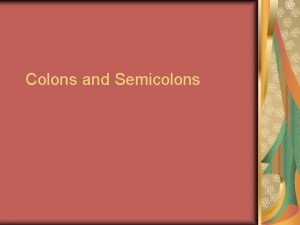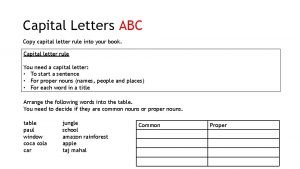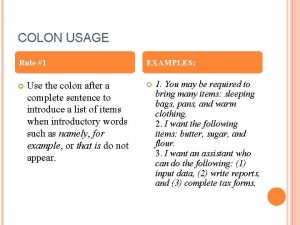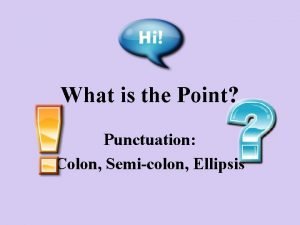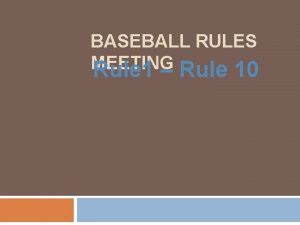COLON USAGE Rule 1 Use the colon after







- Slides: 7

COLON USAGE Rule #1 Use the colon after a complete sentence to introduce a list of items when introductory words such as namely, for example, or that is do not appear. EXAMPLES: 1. You may be required to bring many items: sleeping bags, pans, and warm clothing. 2. I want the following items: butter, sugar, and flour. 3. I want an assistant who can do the following: (1) input data, (2) write reports, and (3) complete tax forms.

Rule #2 A colon should not precede a list unless it follows a complete sentence. EXAMPLES: 1. There are three ways a waitress can make a good impression on her boss and her customers: (a) Dress appropriately. (b) Calculate the bill carefully. (c) Be courteous to customers.

Rule #3 Capitalization and punctuation are optional when usingle words or phrases in bulleted form. If each bullet or numbered point is a complete sentence, capitalize the first word and each sentence with proper ending punctuation. The rule of thumb is to be consistent. EXAMPLES: 1. I want an assistant who can do the following: (a) input data, (b) write reports, and (c) complete tax forms. 2. The following are requested: (a) Wool sweaters for possible cold weather. (b) Wet suits for snorkeling. (c) Introductions to the local dignitaries. NOTE: With lists, you may use periods after numbers and letters instead of parentheses. These are some of the pool rules: 1. Do not run. 2. If you see unsafe behavior, report it to the lifeguard. 3. Have fun!

Rule #4 Use the colon to introduce a direct quotation that is more than three lines in length. In this situation, leave a blank line above and below the quoted material. Single space the long quotation. Some style manuals say to indent one-half inch on both the left and right margins; others say to indent only on the left margin. Quotation marks are not used. EXAMPLES: The author of Touched, Jane Straus, wrote in the first chapter: Georgia went back to her bed and stared at the intricate patterns of burned moth wings in the translucent glass of the overhead light. Her father was in “hyper mode” again where nothing could calm him down.

Rule #5 Use the colon to follow the salutation of a business letter even when addressing someone by his/her first name. Never use a semicolon after a salutation. A comma is used after the salutation for personal correspondence. EXAMPLE: Dear Ms. Rodriguez:

YOU TRY… Where would we place the semincolon? The Endangered Species Act contains a potential problem for private property owners the government refuses to compensate them for the inconveniences imposed. Where would we place the colons? Images of stylish men appear in the following media GQ Magazine, television commercials, and billboard advertisements.

SEMICOLONS Use a semicolon in compound sentences We previously learned that you can use a comma and a coordinating conjunction to separate dependent and independent clauses. You can ALSO use a semicolon. Make sure if you use a semicolon that you DO NOT use a coordinating conjunction. Examples: 1. I wasn’t sure if the power was on; I should have asked first. 2. Mary likes soccer; she has been playing for years.

